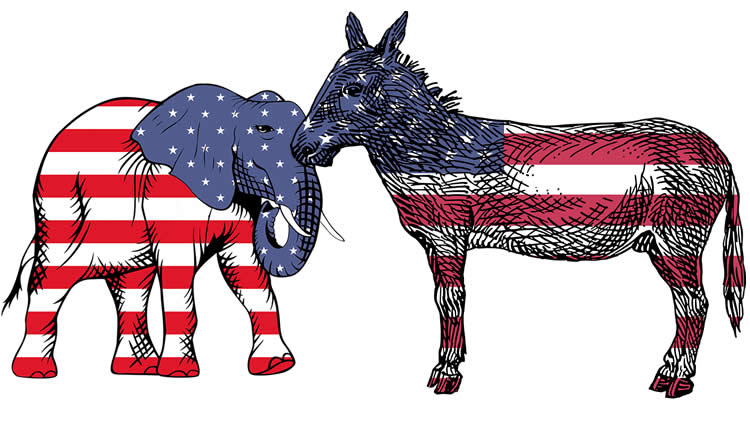Summary: A new study reports language intensity and economic conditions are tied when it comes to how people respond to candidates.
Source: Ohio State University.
Key is interaction of language intensity, economic conditions.
Potential voters who see the nation as being in dire economic straits view a presidential candidate as more “presidential” when he or she uses high-intensity, emotional language, a new study suggests.
But people who think the country is doing just fine think a candidate sounds more presidential when the language is more restrained.
The results of the experimental study may help explain the appeal of Donald Trump and Hillary Clinton to their supporters, said David Clementson, lead author of the study and a doctoral student in communication at The Ohio State University.
“The success of each may boil down to which candidate does better matching his or her language intensity with their audience,” Clementson said.
The study appears in the September 2016 issue of Presidential Studies Quarterly. Clementson conducted the study with Paola Pascual-Ferra of Loyola University Maryland and Michael Beatty of the University of Miami.
The study involved 304 college students and was conducted just weeks before the 2012 presidential election.
Each student participant was given one of two hypothetical economic scenarios to consider. Both were tailored to a college audience. In one, the national economy is strong, 50 percent of college loans can be forgiven, and recent college graduates have no trouble finding high-paying jobs.
In the second scenario, the economy is in recession, the federal government is requiring students to pay some of their student loans early, and college graduates can’t find jobs.
They were then told to read part of a speech that was being given by a presidential candidate.
Some read a speech that used low-intensity language. For example, this candidate said, “This election presents a choice between two contrasting visions for our country” and “Your vote is an opportunity to express your opinion for the direction of our future.”
Others read a speech in which the candidate used high-intensity language, such as “This election is the most important election of your life” and “A vote for me is a vote for your livelihood.”
Each participant then rated how “presidential” and how “trustworthy” each candidate sounded in their speeches.
Results showed that the participants preferred different types of speeches from the candidates, depending on the economic conditions in their scenario.
Those who were given the recession scenario thought the candidate who used high-intensity, fiery language sounded most presidential.
“They wanted a candidate whose language was a little over the top, who promised big things to fix the economy,” Clementson said.
But participants who were given the good-times scenario had a different view of what sounded presidential — they preferred the candidate who used calmer, less-intense language.
For perceptions of trustworthiness, low-intensity language worked in either economic situation, but especially for good times.
“In bad economic times, participants thought the candidates were equally trustworthy if they used high- or low-intensity language,” he said.
“But in the scenario where times were good, the participants thought the candidate using the more restrained language was more trustworthy.”

The results suggest there isn’t one type of language that will always appeal to voters, Clementson said.
“Politicians don’t seem to know when to express emotional language and when to restrain themselves.
“That may be because the audience doesn’t always want the same kind of language from candidates. It’s about expectations. They want candidates who reflect how they’re feeling at that time about the state of the economy.”
In 2016, Trump is the candidate who uses the most intense language, so he will appeal to those who are most upset about the direction of the country, Clementson said.
Clinton uses a combination of high- and low-intensity language in her speeches, he said.
“Clinton uses some strong language stating that the economy is not good for many Americans, but she also is less prone to use high-intensity rhetoric. Her language in general would appeal more to those who are satisfied with the state of the economy.”
Source: David Clementson – Ohio State University
Image Source: NeuroscienceNews.com image is in the public domain.
Original Research: Abstract for “When Does a Presidential Candidate Seem Presidential and Trustworthy? Campaign Messages Through the Lens of Language Expectancy Theory” by David E. Clementson, Paola Pascual-Ferrá and Michael J. Beatty in Presidential Studies Quarterly. Published online August 2016 doi:10.1111/psq.12299
[cbtabs][cbtab title=”MLA”]Ohio State University. “Calm or Firey? Language of Political Candidate Should Match the Times.” NeuroscienceNews. NeuroscienceNews, 29 August 2016.
<https://neurosciencenews.com/political-language-psychology-4925/>.[/cbtab][cbtab title=”APA”]Ohio State University. (2016, August 29). Calm or Firey? Language of Political Candidate Should Match the Times. NeuroscienceNew. Retrieved August 29, 2016 from https://neurosciencenews.com/political-language-psychology-4925/[/cbtab][cbtab title=”Chicago”]Ohio State University. “Calm or Firey? Language of Political Candidate Should Match the Times.” https://neurosciencenews.com/political-language-psychology-4925/ (accessed August 29, 2016).[/cbtab][/cbtabs]
Abstract
When Does a Presidential Candidate Seem Presidential and Trustworthy? Campaign Messages Through the Lens of Language Expectancy Theory
Presidential candidates use different language intensity in different situations. However, the literature is unclear as to when they should use low- or high-intensity language. We applied language expectancy theory and Edwards’ theory of presidential influence to situations varying in circumstances during a presidential campaign. Results indicated significant interactions between language intensity and economic conditions. In support of theories of persuasion applied to presidential campaign contexts, the effects of language intensity and circumstances each depend on the other. During exigent economic times, people consider a presidential candidate to have more presidentiality and trustworthiness when using high- instead of low-intensity language. And during stable economic times, people consider a presidential candidate to have more presidentiality and trustworthiness when using low- instead of high-intensity language.
“When Does a Presidential Candidate Seem Presidential and Trustworthy? Campaign Messages Through the Lens of Language Expectancy Theory” by David E. Clementson, Paola Pascual-Ferrá and Michael J. Beatty in Presidential Studies Quarterly. Published online August 2016 doi:10.1111/psq.12299






